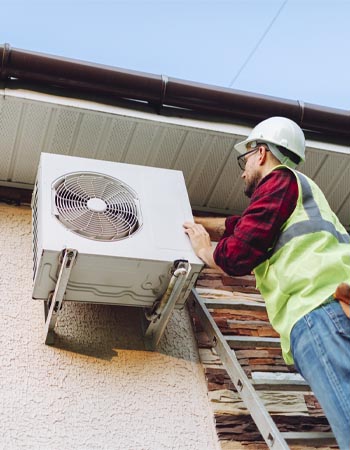We may earn revenue from the products available on this page and participate in affiliate programs. Learn More ›
What You Need to Know
- Home warranty policies usually cover AC repairs, though it may be harder to get your policy to cover AC unit replacement.
- After you file a claim and pay a service fee, a technician will inspect the unit and make recommendations to the home warranty company.
- If the unit has been repaired several times, the home warranty company may approve a replacement. However, if replacement is denied, you can file an appeal.
- If the AC unit was damaged by a covered peril, check to see if your homeowners insurance will cover a replacement. If not, start looking into financing options to help pay for your new AC unit.
A hot house on a scorching summer day is a misery no homeowner wants to experience. A broken air conditioning unit is more than just an inconvenience; it can create uncomfortable living conditions, and even health risks. But homeowners who have invested in home warranty costs may have a potential solution.
Still, it’s important for homeowners to recognize that every home warranty is unique, with coverage varying significantly among providers. To learn how to get a home warranty to replace an AC unit, homeowners can begin with this essential guide, which will walk them through the entire process step by step.
STEP 1: Read your home warranty policy thoroughly to determine what is and isn’t covered.

From the plumbing to the HVAC, home warranty coverage makes it easier for homeowners to keep their home’s critical systems and appliances in good working condition. But while the benefits of a home warranty may be obvious, the precise details of this type of coverage may be less clear. While most home warranties cover HVAC repairs and the replacement of specific AC components, using a home warranty to replace the entire AC unit may be more complicated.
“When it comes to air conditioning, most home warranty plans will cover repairs to essential AC components,” explains Crystal Olenbush, a real estate agent with Austin Real Estate who has been recognized as one of the top luxury real estate agents in Austin, Texas. “However, the details can vary between providers and specific plans. Be sure to thoroughly review your contract to understand exactly what is and isn’t included. The last thing you want is to find yourself with a big repair bill assuming something was covered.”
Examples of covered AC components include compressors, coils, and thermostats. To understand whether their home warranty will cover a broken air conditioning unit, homeowners will need to review their policy documents or contact their provider directly.
STEP 2: File a claim with your home warranty company and pay the service fee.
Once they confirm that AC unit coverage is included with their home warranty plan, homeowners will need to submit a formal claim. Most home warranty companies accept these claims online or over the phone. When submitting their claim, homeowners will want to share as much detail as possible. This will include the age and condition of the unit as well as any maintenance records from the last 12 months.
“If an issue does arise, the claims process generally starts with contacting your warranty company,” says Olenbush. “They’ll arrange for a licensed technician to inspect the problem. The technician will assess what’s wrong and, if approved for coverage, proceed with repairs.”
Olenbush notes that homeowners will need to be prepared to pay an out-of-pocket service fee to schedule the necessary work to get their AC unit back up and running. On average, home warranty services fees range from $55 to $150, though homeowners can confirm the exact cost of their service fee by reading their policy documents.
STEP 3: A tech will inspect the unit and make recommendations on next steps.
Once the claim has been filed and the service fee paid, homeowners can expect their home warranty company to dispatch a technician to inspect the AC unit. The technician will closely examine the broken or malfunctioning unit to determine the root cause of the problem. Both the extent of the problem and the feasibility of repair will be crucial factors in determining the next steps in the process.
If the issue falls under the homeowner’s AC warranty and a simple repair is possible, the technician may fix the unit on the spot. However, if the problem is extensive or a complete replacement of the unit is necessary, the technician will likely report back to the home warranty company to determine how it would like to proceed. Even if the company is willing to approve an air conditioning unit replacement, there may be specific limitations homeowners need to be aware of.
STEP 4: The home warranty company may approve a replacement if the unit has been repaired multiple times.
Home warranty companies may be willing to replace air conditioning units in a few different scenarios. For example, if the unit has been repaired multiple times, this may indicate an ongoing issue that is unlikely to be solved by an additional repair. In this situation, home warranty providers may be more likely to approve a home AC replacement. A replacement may also be approved if the AC components are beyond repair or the cost of repairs exceeds the price of a new unit.
“If a full replacement is needed rather than just repairs, the warranty may cover replacing the entire unit depending on the plan, but there could be limits on what parts or how much of the cost [it covers],” explains Olenbush. She advises homeowners to take the time to understand the terms of their coverage before a breakdown occurs.
Homeowners will want to take the time to understand any applicable coverage limits, which dictate the maximum amount the home warranty company is willing to pay on repairs and replacements. Depending on the coverage limits, homeowners could end up with a lower-quality unit than what they started with. Alternatively, they could also choose to pay for part of the replacement themselves, allowing them to secure a more expensive system. Either way, even the best home warranties have limitations, and homeowners will want to be familiar with these limitations ahead of time.

STEP 5: If the replacement is denied, consider filing an appeal.
There are some situations in which home warranty companies might deny the replacement of an air conditioner. Homeowners may have their claim denied if the damaged components are not covered under their plan, or if the problem is the result of something other than normal wear and tear. However, homeowners with denied claims don’t have to accept defeat just yet: Filing an appeal is always an option.
Before filing an appeal, homeowners can begin by examining their home warranty contract, paying close attention to terms and conditions to understand exactly what is covered under their plan. This will help them determine whether there are grounds for the company’s denial. Next, homeowners will need to request a copy of the inspection report. This document will detail the technician’s findings as well as the basis for the denial.
Armed with this information, homeowners will need to contact their home warranty company’s customer service department. During this conversation, the company may request additional records or documents. Because this process can vary somewhat between providers, homeowners will need to work with their home warranty company to understand any additional steps in the appeals process.
STEP 6: File a homeowners insurance claim if the AC unit was damaged by a covered peril.
If the AC damage does not qualify for coverage under a home or air conditioner warranty, there may be other options homeowners can explore to cover the cost of a replacement. For example, depending on the cause of the damage, the best homeowners insurance companies (such as Allstate or Lemonade) may help pay to replace a damaged air conditioner. Homeowners insurance typically covers damage caused by covered perils including storms, natural disasters, and vandalism. If one of these perils caused damage to the AC, it’s possible homeowners insurance might help.
When filing a homeowners insurance claim, homeowners will need to be prepared to answer questions about the incident, including the date and time of the damage. Once all the information has been collected, the insurance company will likely send an adjuster to inspect the unit and assess the situation firsthand. Having a documented history of AC maintenance to present can be helpful during this process. Once the adjuster completes their investigation, the insurance company will determine whether the damage falls under the policy’s coverage and, if so, how much it will contribute for an air conditioning replacement. Homeowners will want to note that a deductible (the portion of the claim the homeowner must pay before insurance will cover it ) will apply.
STEP 7: If all else fails, look into financing options to help pay for a new AC unit.
If neither homeowners insurance nor a home air conditioning warranty will pay for an AC replacement, homeowners may need to turn to alternative financing options. These options include credit cards, personal loans, home equity loans, and home equity lines of credit. However, it’s important to recognize that each of these forms of financing comes with its own pros and cons, so homeowners will need to choose the financing option that best aligns with their needs.
A credit card may be a good option for inexpensive replacements, such as window units, though homeowners will want to be wary of high interest rates. Opening a credit card with a zero percent introductory interest rate can also be an option if the homeowner plans on paying it off during that intro period. One of the best home equity loans (such as one from U.S. Bank or Flagstar Bank) may be a better option for homeowners looking to cover expensive central AC unit costs. However, homeowners will want to note that their home will be used as collateral to secure the loan, so failure to repay the loan could result in the lender repossessing the home. To find the best option for their situation, homeowners will need to pay close attention to terms and conditions, taking note of interest rates, repayment schedules, and the total cost of the loan, among other factors.
When an air conditioning unit breaks down, it’s understandable that homeowners are eager to get it back up and running. To replace their AC, home warranty customers have a few options. If the damage is a result of normal wear and tear, their home warranty company may be willing to pay to replace the broken unit. Alternatively, if damage was caused by a natural disaster, vandalism, or other covered perils, their homeowners insurance policy may help cover a portion of the cost.
But there are also steps homeowners can take to protect their AC unit from future harm. Choosing one of the best home warranties for HVAC systems (such as coverage through American Home Shield or Liberty Home Guard) is one way that homeowners can protect their AC unit in the event of damage or a breakdown that may occur down the road. Working with one of the best AC installation companies can also be helpful, as doing so can ensure the system is properly installed to begin with. By taking these preventive measures, homeowners may be better equipped to keep their air conditioner in good working condition, maintaining a comfortable living environment all season long.


